Trees Birds Mammals Fish Amphibians Reptiles
Wild Algarve
Bookshop
Volvopluteus gloiocephalus (DC.) Vizzini, Contu & Justo - Stubble Rosegill
Phylum: Basidiomycota - Class: Agaricomycetes - Order: Agaricales - Family: Pluteaceae
Distribution - Taxonomic History - Etymology - Identification - Culinary Notes - Reference Sources
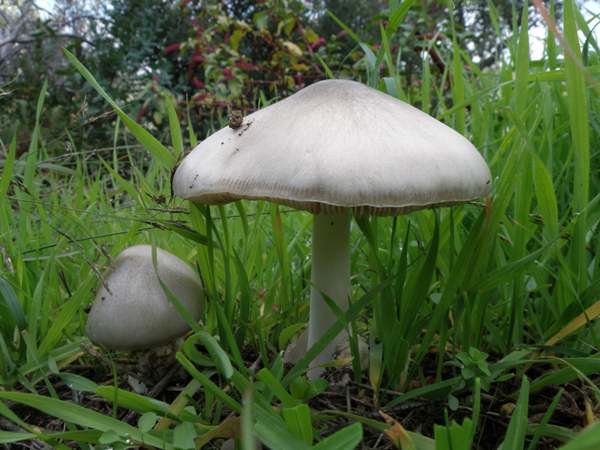
Amanita fungi are not the only ones that have a volva at the stem base; mushrooms in the genus Volvariella do so as well. Volvariella gloiocephala (syn. Volvariella speciosa) does indeed grow in fields where crops have been harvested to leave stubble (and it doesn’t have to be cereal crops; I have seen cleared cabbage fields dotted with hundreds of these large white mushrooms). Grassy roadside verges and permanent pastures are also places where this handsome mushroom can appear.
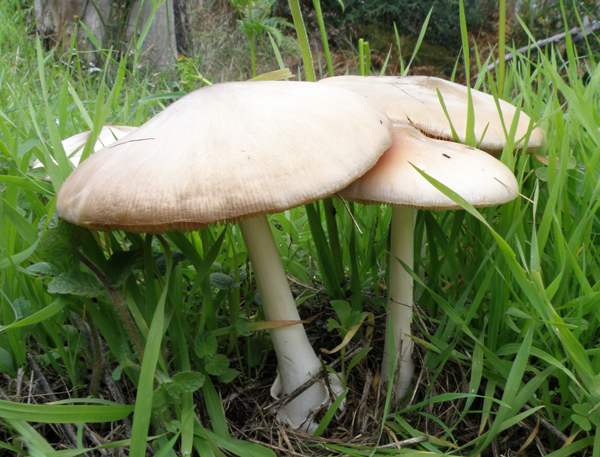
Distribution
The Stubble Rosegill is fairly common in Britain and Ireland, where it is most often seen in fields that have been harvested of a grain crop (or occasionally some other food crop such as cabbages). This mushroom is even more widespread and abundant in southern mainland Europe, often recurring in the same grassy areas
for many years.
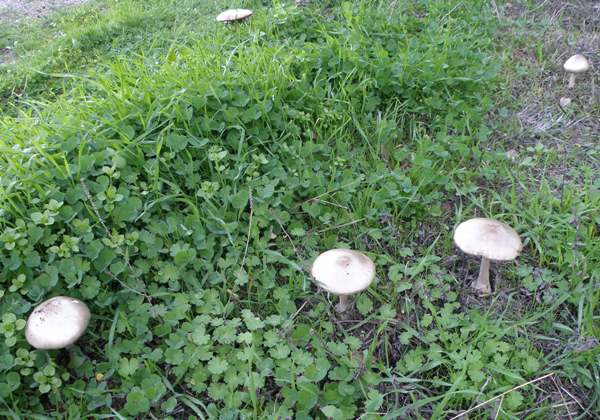
Taxonomic history
When Swiss mycologist Augustin Pyramus de Candolle described this mushroom in 1815 he called it Agaricus gloiocephalus. (Most gilled fungi were initially placed in a giant Agaricus genus, now redistributed to many other genera.) Until recently its generally-accepted scientific name dated from 1986, when mycologists Teun Boekhout and Manfred Enderle gave it the name Volvariella gloiocephala. Then, in a 2011 publication by Italian mycologist Alfredo Vizzini and colleagues, the Stubble Rosegill acquired the new name Volvopluteus gloiocephalus.
Many older field guides use the name Volvaria speciosa when referring to this species, but now more authorities refer to it as Volvopluteus gloiocephalus (DC.) Vizzini, Contu & Justo (2011), with this being the type species of the newly created genus Volvopluteus.
Synonyms of Volvopluteus gloiocephalus include Agaricus gloiocephalus DC., Amanita speciosa Fr., Agaricus speciosus (Fr.) Fr., Volvaria speciosa (Fr.) P. Kumm., Volvaria gloiocephala (DC.) Gillet, Volvaria speciosa var. gloiocephala (DC.) R. Heim, Volvariella speciosa (Fr.) Singer, Volvariella speciosa var. gloiocephala (DC.) Singer, Volvariella speciosa f. gloiocephala (DC.) Courtec., and Volvariella gloiocephala (DC.) Boekhout & Enderle.
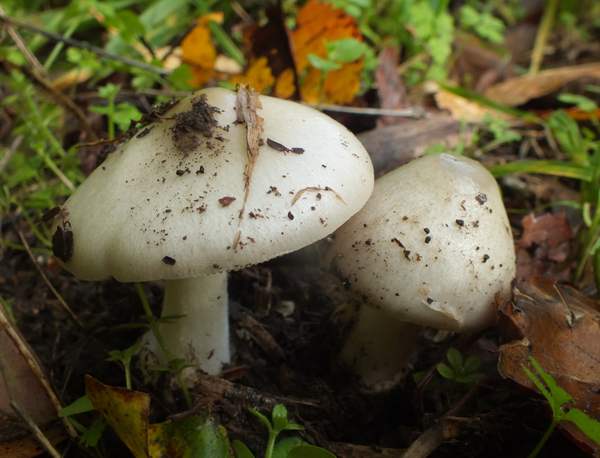
Etymology
Volvopluteus, the genus name, is a reference to the volva formed around the stem base by the remnants of the membranous universal veil which covers emerging fruitbodies, and its relationship with another pink-spored genus the shield mushrooms, Pluteus species. The specific epithet gloiocephalus comes from the Greek words gloio, meaning glue or glutinous substance, and cephalus, meaning head. Hence gloiocephalus means with a sticky head - a reference to the viscid nature of the surface of caps of the Stubble Rosegill.
Identification guide
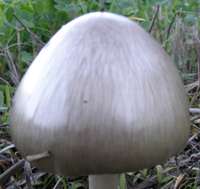 |
Cap
8 to 14cm across; initially oval becoming convex but not often flattening completely; white, often with a greyish-brown centre, becoming cream and eventually ochre; sticky when moist, silkily smooth when dry. |
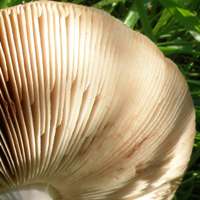 |
Gills
Free; crowded; white at first, becoming pink. |
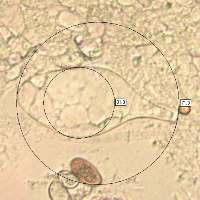 |
Cheilocystidia
Variable but often clavate or utriform, 50-100 x 15-40µm.
Pleurocystidia
Similar to the cheilocystidia but often slightly broader. |
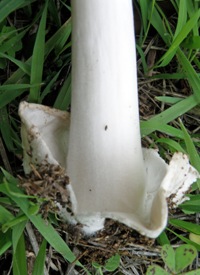 |
Stem
10 to 15cm long and 1 to 1.5cm dia.; white; tapering towards apex; no ring. There is a persistent fleshy bag-like volva (left) at the base. |
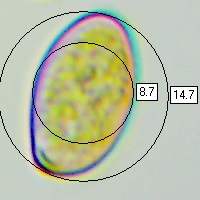 |
Spores
Ellipsoidal, smooth, 13-18 x 8-10µm.
Spore print
Pink. |
Odour/taste |
Pleasant and mild but not distinctive. |
Habitat & Ecological role |
Saprotrophic in nutrient-rich damp permanent pasture, roadside grassland and stubble fields; occasionally also in fields where brassicas have been harvested. |
Season |
July to November in Britain and Ireland; appearing through until early March in some southern European countries including Spain and Portugal. |
Similar species |
Volvariella bombycina has a very silky (almost hairy) cap and a volva; it grows on damaged hardwood trees and on their dead trunks and large branches.
Amanita virosa has a stem ring and occurs in woodland habitats. |
Culinary Notes
The Stubble Rosegill is generally regarded as an edible mushroom although not highly rated. Because this mushroom can easily be confused with deadly Amanita species (such as Deathcap and Destroying Angel) which also have stem-base volvas and pale caps, great care is essential to ensure that there is absolutely no doubt at all about identification. Inexperienced mushroom gatherers should avoid gathering any fungi that have volvas.
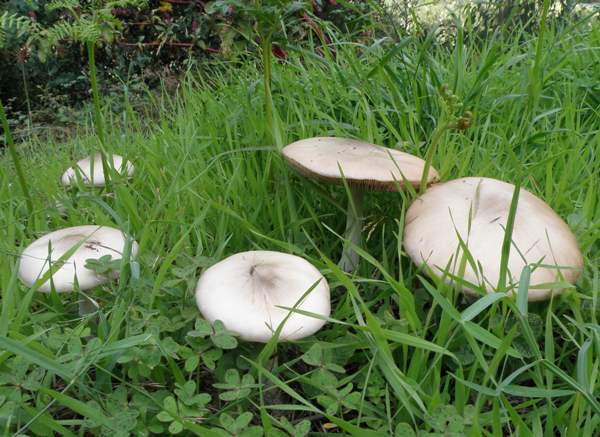
Reference Sources
Fascinated by Fungi, 2nd Edition, Pat O'Reilly 2016, reprinted by Coch-y-bonddu Books in 2022.
Alfredo Justo, Andrew M. Minnis, Stefano Ghignone, Nelson Menolli Jr., Marina Capelari, Olivia Rodríguez, Ekaterina Malysheva, Marco Contu, Alfredo Vizzini (2011). 'Species recognition in Pluteus and Volvopluteus (Pluteaceae, Agaricales): morphology, geography and phylogeny'. Mycological Progress 10 (4): 453–479.
Orton, P.D. (1986). British Fungus Flora: Agarics and Boleti. Vol 4. Pluteaceae: Pluteus & Volvariella. Royal Botanic Garden: Edinburgh, Scotland.
BMS List of English Names for Fungi
Dictionary of the Fungi; Paul M. Kirk, Paul F. Cannon, David W. Minter and J. A. Stalpers; CABI, 2008
Taxonomic history and synonym information on these pages is drawn from many sources but in particular from the British Mycological Society's GB Checklist of Fungi.
Acknowledgements
This page includes pictures kindly contributed by Simon Harding.
Top of page...
Fascinated by Fungi. Back by popular demand, Pat O'Reilly's best-selling 450-page hardback book is available now. The latest second edition was republished with a sparkling new cover design in September 2022 by Coch-y-Bonddu Books. Full details and copies are available from the publisher's online bookshop...